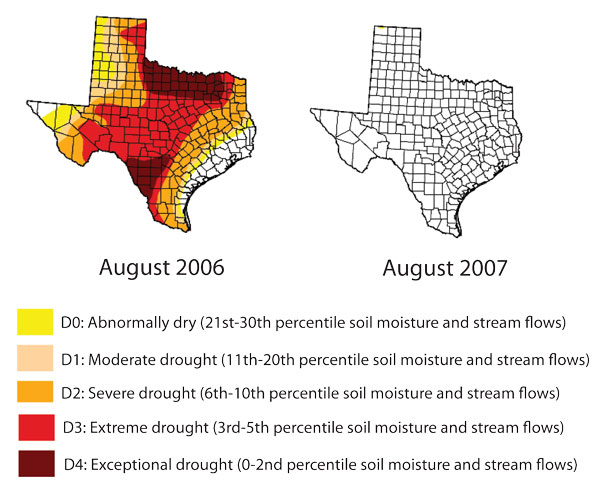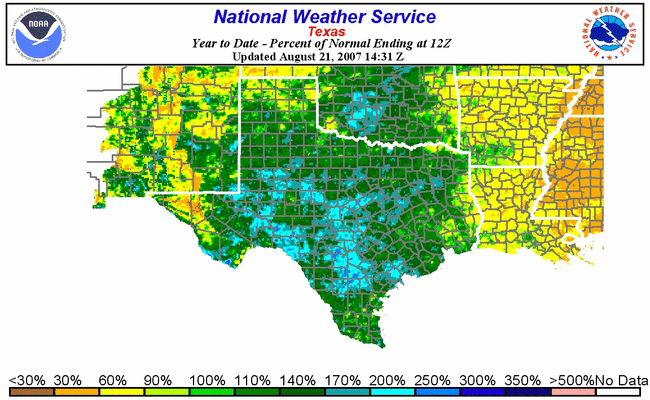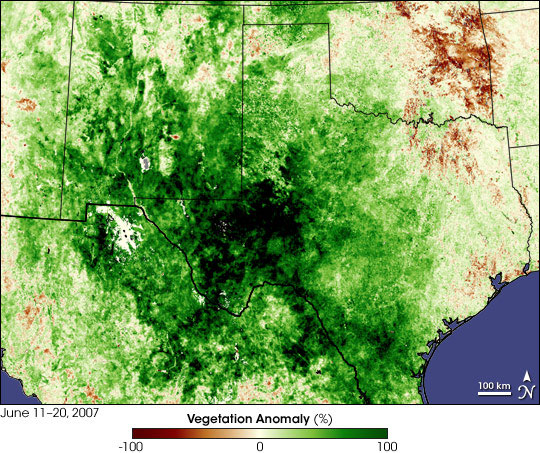2006-2013 updates for the article "Rainfall patterns at the Fly Gap Division of the Double Helix Ranch, Mason County, Texas," by David M. Hillis. More recent updates follow the original article.
When I first wrote this article, in summer 2006, the ONI was climbing out of the negative territory it had been in since fall 2005 (when our 2005-2006 drought began). The ONI was predicted to increase, and to keep climbing for the remainder of 2006, suggesting moderate El Niño conditions developing in late 2006 and early 2007, and therefore forecasting an end to the severe 2005-2006 drought. This happened exactly as predicted. We had a wet early half of 2007, which pulled us out of the 2005-2006 drought, as seen in these maps from the National Drought Mitigation Center:
In August 2006, over 90% of Texas was in one of the drought categories, with 73% of the state in severe, extreme, or exceptional drought. After the rains in the first half of 2007, the entire state was free of drought, with many areas experiencing record rainfall. This map from the National Weather Service shows the rainfall (as a percent of normal) for 1 January to 21 August 2007:
All this rain stimulated substantial vegetative growth, as seen in this NASA map of vegetative growth in June of 2007:
Most of Texas showed far more vegetative growth than usual in the spring and summer of 2007, and the areas in eastern Texas that are not green on this map were under heavy cloud cover when the satellite data for this image were collected.
During the latter half of 2007, we returned to La Niña conditions, and they continued throughout 2008 and the first five months of 2009, as seen in this summary of sea surface temperatures from the Pacific presented by the NOAA/National Weather Service Climate Prediction Center (in particular, notice the negative deviations in the critical El Niño 3.4 region throughout most of 2008 and early 2009):
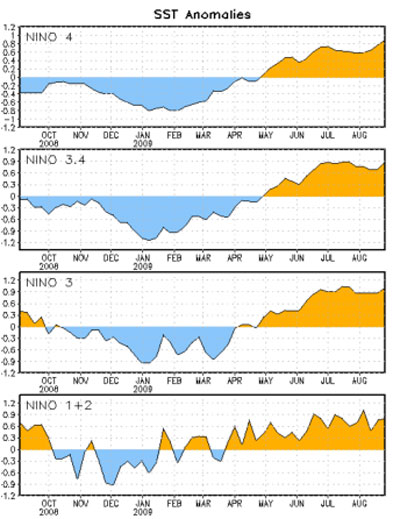
These 2007-2009 La Niña conditions resulted in a return to our dry weather pattern for the latter part of 2007 through the first half of 2009. There was a brief period of some relief in summer 2008 in parts of central Texas, when our rainfall was a little closer to normal, but then a return to La Niña conditions, as well as a return to severe drought by late 2008 and the first half of 2009 (as monitored by the National Drought Mitigation Center):
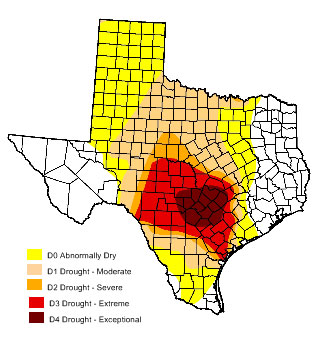
January 2009
In the first half of 2009, the worst of the drought shifted and expanded into south Texas, with some relief in north-central Texas, but intensification in south Texas. A sharp line running through the Edwards Plateau separated nearly normal conditions in much of the northern and western portion of the Plateau and in north and west Texas from the severe to exceptional drought that gripped the southern and eastern parts of the Plateau and all of south Texas:
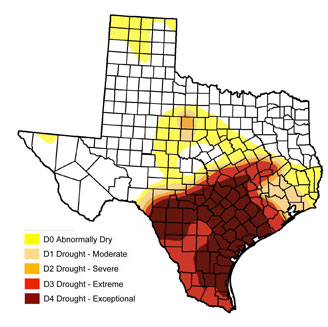
August 2009
The good news, however, was the forecast for an El Niño episode in fall and winter 2009-2010. We had already returned to El Niño conditions as of summer 2009, and virtually all the models monitored by the NOAA/National Weather Service Climate Prediction Center predicted a developing El Niño for fall and winter 2009-2010:
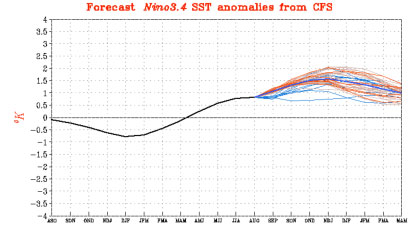
Predictions of Sea Surface Temperatures in the El Niño 3.4 region, in August 2009
The black line shows the observed departures of sea-surface temperatures in the El Niño 3.4 region. The heavy blue line is the average of the various forecast models (shown by thin lines), as of August 2009. Thus, the models forecast a switch from a La Niña pattern to an El Niño pattern, and thus wetter conditions for late 2009 and early 2010 in central Texas. An El Niño episode gives us about a 70–80% chance of above average rainfall for October through March. There was a slight weakening of the El Niño development in August 2009, but almost all the models predicted a strengthening of El Niño conditions through the rest of 2009, which is exactly what happened.
The following maps show the longterm preciptation predictions during three-month periods for September 2009 until October 2010 (predictions from August 2009). Notice that central and south Texas were predicted to have above average rainfall (shown in green) for each of the periods from October-November-December 2009 to March-April-May 2010 (from the US Drought Monitor service operated by the USDA and NOAA):
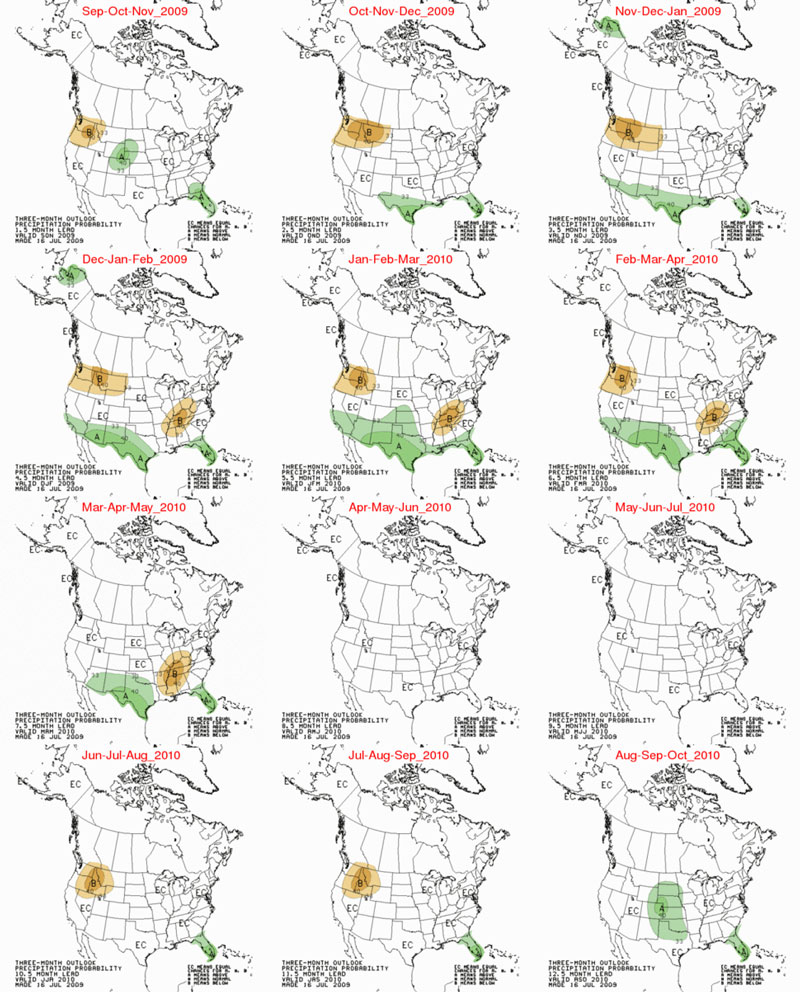
Here is the 12-month running total for rainfall at Fly Gap for the decade from 2000-2010, showing how the peaks and valleys at Fly Gap (in Mason County, in the geographical center of the state) relate to drought conditions throughout the rest of Texas (the drought maps come from the National Drought Mitigation Center):
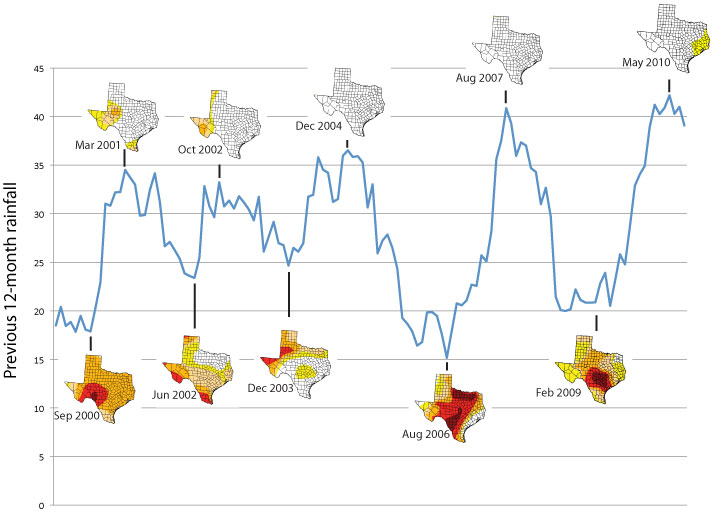
Update, 26 October 2009:
Just a full month into fall, and the predicted effects of El Niño (a rainy fall pattern, with regular Pacific moisture streaming over central Texas) are already quite evident. At the Double Helix Ranch in Mason County, we are already over our long-term average rainfall for the year. The landscape has greened up nicely with the recent rains, the stock tanks are full, and the streams are flowing. We have already had over 12" of rain in September and October 2009, and even larger totals have fallen over much of central Texas, with widespread totals between 10" and 25". Here is a map of the rainfall for the past two months, shown as a percent of the long-term average on the left, and in inches on the right:
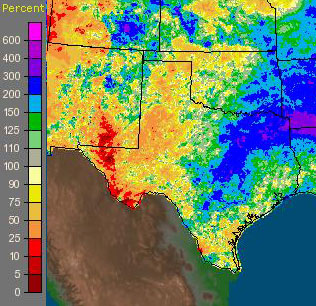
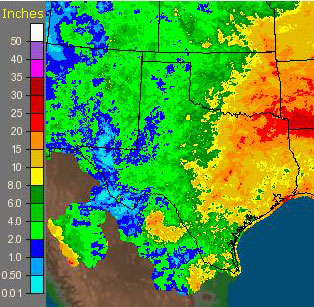
Notice that much of central Texas has had over twice its average rainfall for the past two months, and almost all of central Texas has had above average rainfall during this period. This wet pattern is expected to continue through the fall and winter. Most of the months that show the biggest increases from El Niño conditions are still ahead of us (October through March).
If we just look at the October-through-March period to date, the El Niño effects are even clearer (the maps below show the rainfall from 1-26 October 2009, as a percent of the long-term average for this period on the left, and in inches on the right):
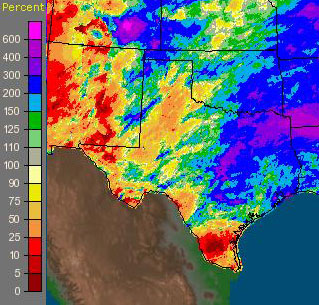
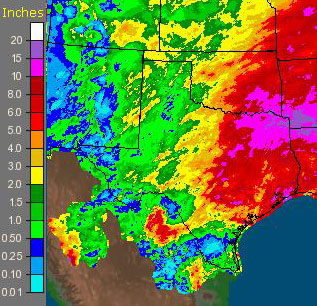
On this map, notice that all of central Texas is well above average for rainfall in October 2009, with some areas receiving three to six times the long-term average rainfall, and widespread areas receiving two to three times the long-term average. Several areas in central Texas, and all of northeast Texas, have already received over 10" of rain for the month of October alone. An area in deep south Texas has not yet done as well, but the El Niño wet season has just begun. West Texas is also mising out on most of the rain, but that area is somewhat less likely to benefit from wet El Niño events compared to central and south Texas.
The model predictions for the sea-surface temperatures in the El Niño 3.4 region continue to show an El Niño episode through the fall and winter of 2009–2010. The 2009–2010 El Niño episode should become "official" at the end of November 2009 (recall that El Niño episodes are officially declared when the ONI is above 0.5 degrees C for five or more consecutive overlapping three-month periods, which should occur at the end of November):
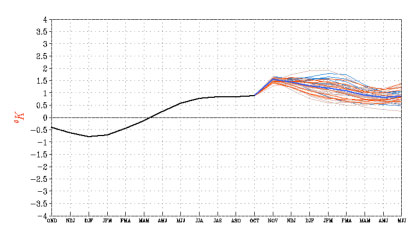
The black line shows the observed departures of sea-surface temperatures in the El Niño 3.4 region. The heavy blue line is the average of the various forecast models (shown by thin lines).
Update, 8 March 2010:
The cool, wet 2009-2010 winter for central Texas developed just as predicted above. As of early March 2010, we have experienced about 42" of rain over the past 12 months (most of which has fallen since September 2009), making this one of the four wettest periods for Fly Gap in the past 60 years. As noted above, all four of the these wettest periods have been associated with El Niño episodes, and all four have occurred within the past two decades. This is consistent with the stronger and more frequent El Niño episodes associated with the global warming that has occurred in recent decades.
Here is the map of rainfall (shown as a percent of normal) from 1 January to 8 March 2010:
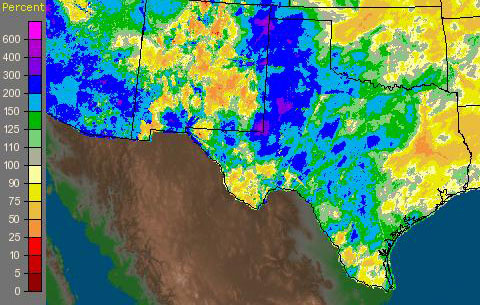
Rainfall, as percent of normal, for 1 Januray 2010 to 8 March 2010
The heaviest rain in fall 2009 fell in central and east Texas (see maps shown in October 2009 update), but the heaviest rains in early 2010 fell in central, north, and west Texas (see map immediately above). Central Texas benefitted from consistently above-average rainfall (and cooler temperatures) through most of the El Niño fall and winter. For the past six months, there is a large swath through central Texas that received 1.5-2 times the average rainfall (typical for an El Niño October to March period in central Texas):
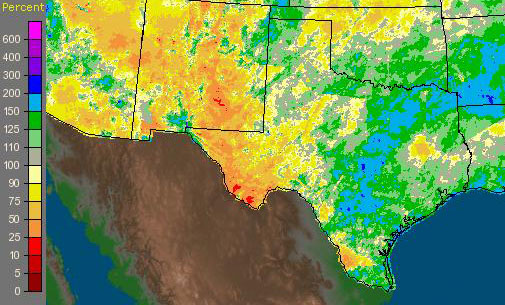
Rainfall, as a percent of normal, for six months ending 8 March 2010
Although most regions of Texas have received normal or above-average rainfall during this six-month period, note that there are still dry areas, especially in Trans-Pecos Texas. Most of west Texas has just begun to receive significant rains since the beginning of the year. The current drought map for Texas shows only two small regions (one in Trans-Pecos and one in south Texas) that are considered "abnormally dry" (the least severe of the drought categories):
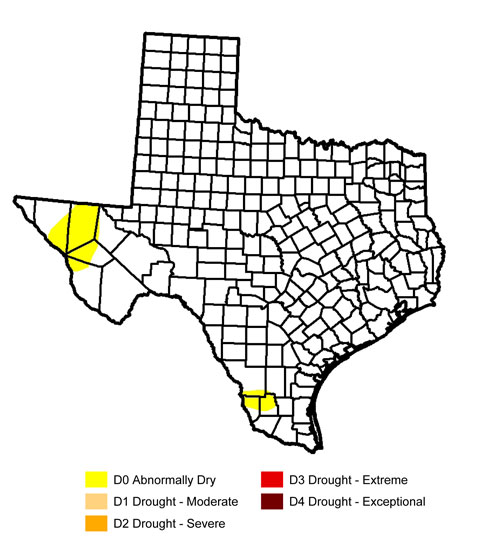
Texas Drought map, 2 March 2010
The forecast calls for the El Niño episode to continue through spring 2010. We are likely to return to near-neutral conditions by summer 2010:
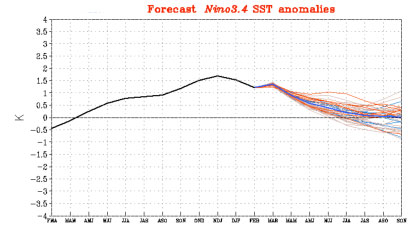
Update, 26 May 2010:
The Spring 2010 wildflower display at the Double Helix Ranch is just nice as predicted!
[Scroll down to see this same scene in 2011, in a La Niña year]
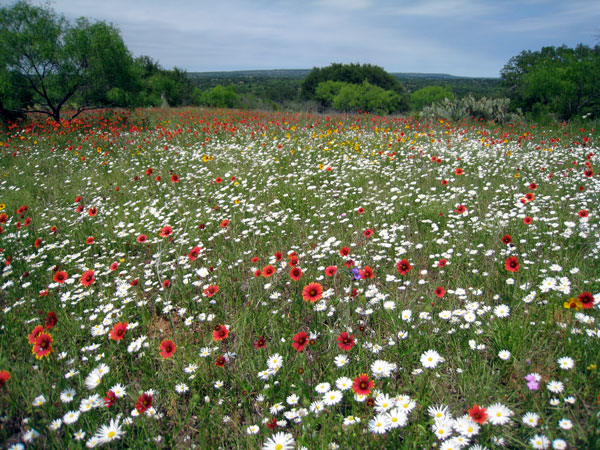
Update, August 2010: The return of La Niña
Enjoy the wet El Niño years in central Texas, because they don't last forever! Unfortunately, the 2009-2010 El Niño is over, and we went from El Niño to neutral to La Niña conditions in summer 2010. As noted above, La Niña conditions usually mean a dry fall through spring in central Texas. Here are the lastest sea surface temperature anomalies in the equatorial Pacific, as of late July 2010:
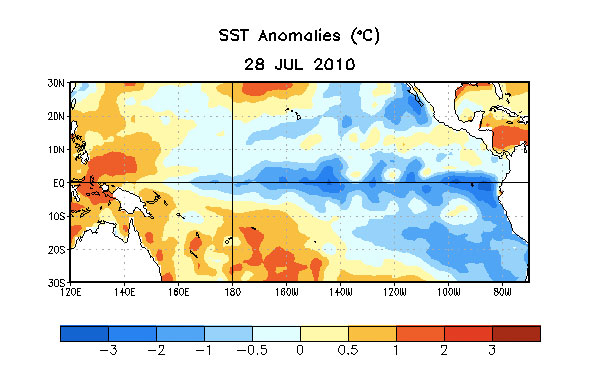
Notice the cold (blue colors) sea surface temperatures all along the equator: the classic La Niña pattern. The follwoing graph shows how quickly we changed from El Niño to La Niña conditions in summer 2010:
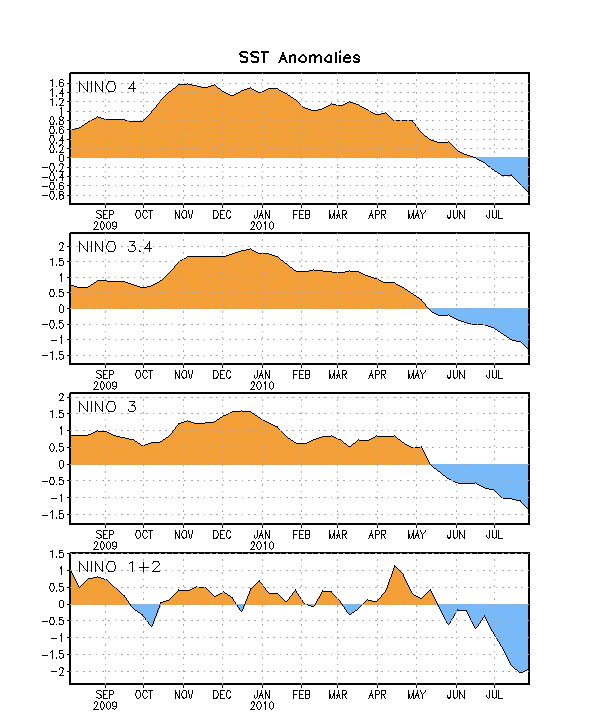
Another way to visualize this is in a graph that shows temperatures along the equatorial Pacific, as they have changed through time from September 2009 to August 2010. The warm temperatures of the El Niño (red colors) are evident from September 2009 through spring 2010, but then shift to cold temperatures (blue colors) in summer 2010 (time is along the vertical axis of this graph):
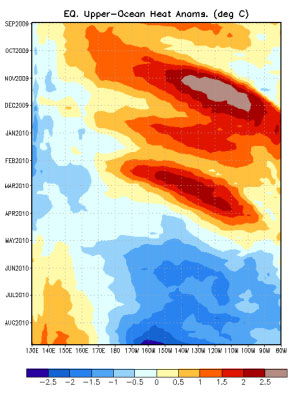
As usual, models vary somewhat regarding the future strength of the developing La Niña episode, but nearly all the models are consistent in forecasting a moderate to strong La Niña from fall 2010 through spring 2011:

Unfortunately, this means a greater chance of below-average rainfall for late 2010 and early 2011 in central Texas. However, La Niña episodes tend to be more variable than El Niño episodes, and not all La Niña episodes result in drought (see above). Our best hope for wet weather comes from the usually more-active tropical storm season during La Niña years, which can bring heavy fall rains to central Texas in the remnants of hurricanes. But based on the last 60 years of La Niña episodes (15 total), we have a 73% chance of a drier-than-average October through March, a 20% chance of near-average rainfall, and about a 7% chance of wetter-than-average conditions.
Update, 8 September 2010: Tropical Storm Hermine brings heavy rains
We didn't have to wait long to get the tropical system discussed above. Tropical Storm Hermine blew through central Texas (and right over Double Helix Ranch) on 7-8 September. The center of the storm moved over the ranch, but the heaviest rains in a tropical system (in the northern hemisphere) are typically on the northern and eastern sides of the storm. We received beneficial rains as Hermine approached, receiving a total of 3.03". We were lucky that we weren't east of the storm, where winds from a high over the southeastern United States fed Gulf of Mexico moisture into the storm's trailing eastern edge, and dropped 8 to 15" of rain along a long band up the I-35 corridor, from San Antonio to Austin and then north to Waco. This heavy rain caused serious flooding. Here is a map showing the rainfall totals for the past week, most of which came from Hermine:
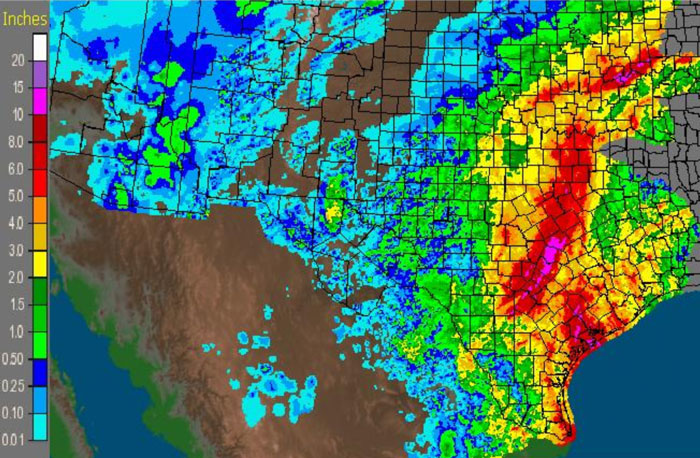
Update, 16 November 2010: Dry La Niña season is here
It is now six weeks into the October to March season when the La Niña/El Niño effects are most evident. As predicted, the 2010-2011 fall to spring season is already very dry, as is typical of a La Niña year. We have had only a trace of rain in the last two months.
I just learned of an excellent web site of the South Llano Watershed Alliance (http://southllano.org/). From this site, I learned of a tree-ring study by Malcolm Cleaveland of the University of Arkansas, as reported by Paul Frommer to the Edwards Aquifer Recovery Implementation Program. For National Weather Service Division 6, which covers central Texas, tree-ring growth indicates the following for the period of 1500 to 2008:
The period 1952–1956 was the fourth driest five-year period during the past 500+ years. The two driest five-year periods were in the 1700s (1713–1717, and 1739–1743), and the third-driest five-year period was in 1804–1808. So the 1950s drought was the worst one (over five years) in the past two centuries. However, when considering single years, 1956 was only the 35th driest year since 1500. Moreover, the second driest ten-year period since 1500 was 1948–1957 (only 1707–1716 was drier). No recent multiyear drought comes close to the drought of the early 1950s (as is also supported above by rainfall data), despite what has been reported in some media outlets.
Update, 7 January 2011: Dry, dry, dry first half of Fall to Spring La Niña period, 2010-2011
As discussed above, the period most affected by the El Niño/La Niña cycle is October to March. I showed a graph of the rainfall for all the El Niño and La Niña episodes for the last 60 years, and noted that in 14 of 15 La Niña years the rainfall for this period was significantly below the October-to-March mean of 12". Halfway through the period in this La Niña cycle, we are far below even the driest of these previous La Niña years so far, with just 1" of rain in October through December 2010 (and almost all of that fell in the last week of December). There is some rain forecast for this weekend, but it will take a lot to get us out of this current dry spell.
Update, 3 April 2011: Sometimes it hurts to be right; La Niña continues, but may be weakening
The six-month period most affected by the El Niño/La Niña cycle (October–March) just ended, and the predicted drought certainly materialized. Here is the graph showing rainfall versus deviation in the ONI index, with the 2011 data added:
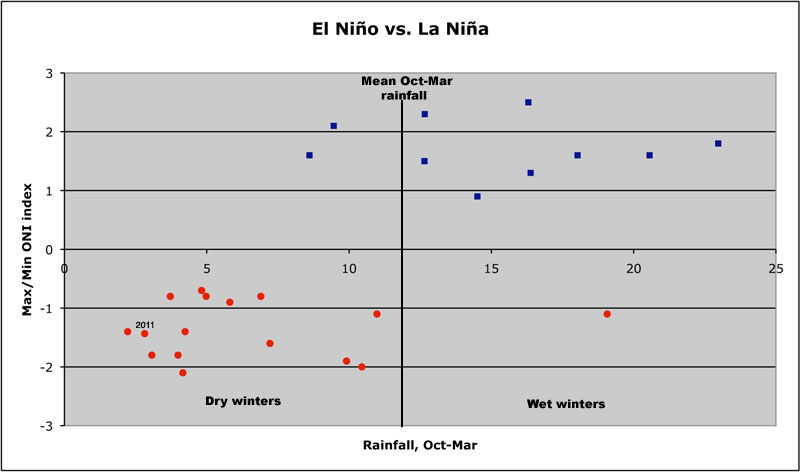
The 2010–2011 La Niña season was the second-driest in the past 60 years, with just 2.72" of rain from October 2010 through March 2011. The calendar says April, but it looks and feels like July in central Texas.
The La Niña conditions are continuing, but the La Niña episode shows some signs of weakening:
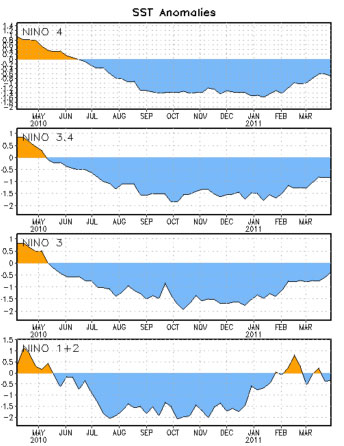
Most models forecast a return to near-neutral conditions this summer:
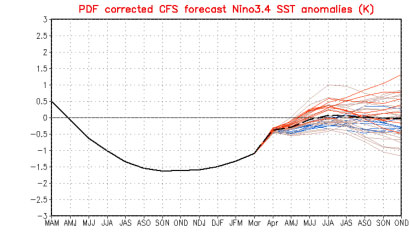
Unfortunately, we are likely looking at continued drought conditions for a while yet. The good news is that a return to more normal conditions is on the (distant) horizon.
Update, 23 May 2011: Some Areas of Central Texas Getting Rain, But Severe Drought Continues
I watched some impressive storms from my front porch at the Double Helix Ranch over the last two weeks, as they dropped heavy rain to our north and east. Alas, all we received were a few drops. Here is a photo of the storms looking northeast from our ranch last week:

The severe la Niña-induced drought of 2010-2011 continues over most of Texas. Here is a map that shows the rainfall since the beginning of October 2010, shown as a percentage of normal rainfall:
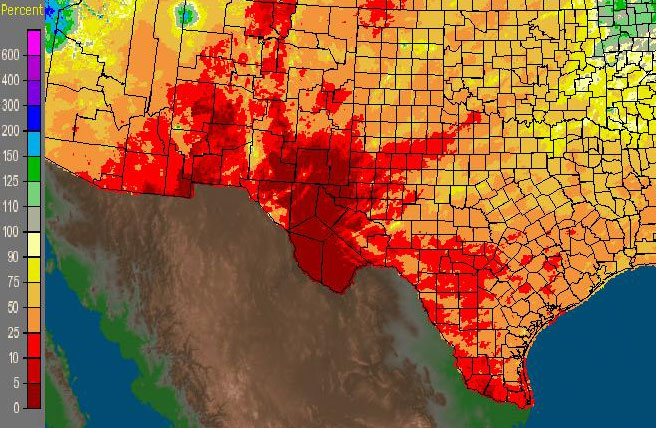
At the Double Helix Ranch, we are at about 25% of normal rainfall over the past 8 months. Most of Texas is at less than 50% of normal rainfall, with the most severe drought in west Texas. Large areas of the Big Bend region have seen no measurable rain during this period.
The drought, combined with high winds, high temperatures, and low humidity, is resulting in major wildfires across much of Texas, especially in the Rolling Plains and in the Trans Pecos region. Below is a photo of the Swenson Fire. which occured just south of our Dumont Division last month. The Brazos River is running black with soot:
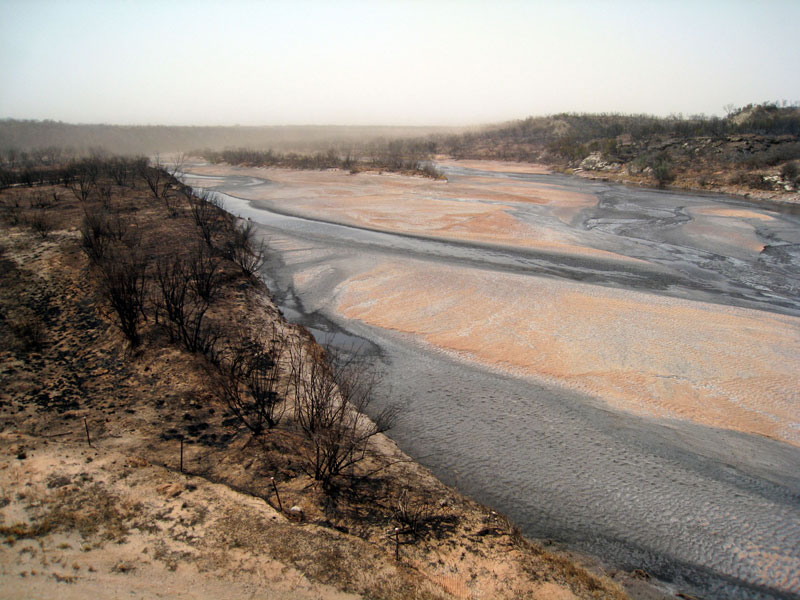
Update, 21 June 2011: Now in the worst drought since the 1950s
With no rain at all since the last update, the Double Helix Ranch is now the driest it has been in my lifetime. I was born in 1958, after the great drought of the early 1950s. I have now seen one of our ranch ponds (or "tanks," as we call them in central Texas) dry for the first time. The Llano River is about to stop flowing at Llano, as it did from late June through August of 1956. The headsprings of the Llano River are approaching the flow rates of the 1950s drought as well. This drought has not yet been nearly as long-lasting as the 1950s drought, but the past nine months have been as dry or drier than the driest periods of the long 1950s drought (which actually consisted of three severe droughts in a row, separated by two short intervals of reasonable rainfall).
As I write this, I am hopefully watching a line of thunderstorms to our north, hoping that they will make it down this way. [That storm brought 1-2" of rain to many areas of central Texas, but only dropped 0.3" at my ranch.] But we need some sustained heavy rain to make a dent in this drought; our best bet for that is a tropical storm from the Gulf of Mexico.
Update, 8 August 2011: We are in record territory, with a poor long-term outlook
It has been a miserable summer, with record heat and virtually no rain in central Texas. In the past 11 months, we have recorded 5.13" of rain at the Double Helix Ranch. We have already recorded less rain in the past year than in any other 12-month period on record, and almost half of that total fell in the first week of September 2010. So, unless we get a big tropical system that drops a lot of rain, in another month our 12-month running total will be at about half the previous record low for any comparable period since rainfall records have been kept.
The early 1950s drought lasted much longer than our current drought has existed so far, but the past year was worse than any single year during that five-year drought-of-record. The question on everyone's mind is: "How much longer will our current drought persist?" Earlier this summer, the long-term models pointed to an end to our La Niña episode, and we have indeed returned to nearly neutral El Niño/La Niña conditions, even though the weather has yet to shift out of the La Niña pattern of hot and dry. The bad news, though, is that some long-term models point to a return to La Niña conditions. Just as some economists are talking about a double-dip recession, there is now a 50% chance of a double-dip La Niña, with about an equal chance for continuing neutral conditions. There is no sign of an El Niño episode that might bring substantial relief in the near future.
The relatively good news: we are indeed currently in neutral El Niño/La Niña conditions:
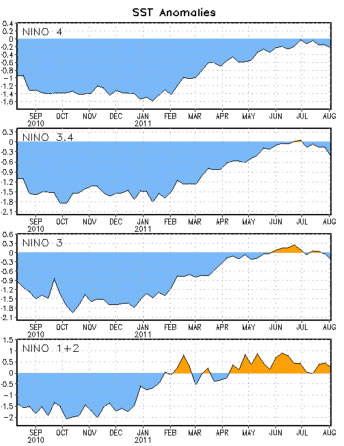
The bad news is that the weather pattern does not have any drivers to change the current conditions, so we are stuck in drought. The Double Helix Ranch shares the unfortunate distinction with much of west and south Texas of receiving only 0–25% of its normal rainfall over the past year:
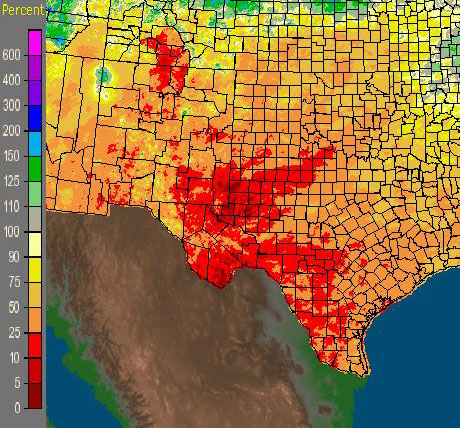
The worse news is that the long-term predictions don't look promising, with the conditions staying neutral at best and returning to another La Niña episode at worst:
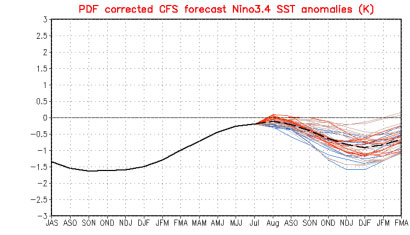
Meanwhile, all our surface water at the ranch is gone, and we are hoping against hope that our last ranch well does not go dry. To conserve what water remains for our cattle, we have abandoned trying to keep our fruit and nut trees alive. Oak trees all over the ranch are dropping their leaves, and we are likely to see many trees lost to this drought even if rains return soon. Our best hope remains a tropical storm, but the tropical season has been a disappointment so far. Tropical Storm Don looked very hopeful last month, but strangely dropped little rain anywhere in Texas, and none at the Double Helix Ranch.
Update, 28 August 2011: A record hot summer, combined with a record drought
We have already had highs of over 100 for 73 days this summer, with highs of 110 the past few days. The live oaks across the ranch are mostly leafless, and the post oaks, blackjack oaks, and Texas red oaks are brown and look like winter:
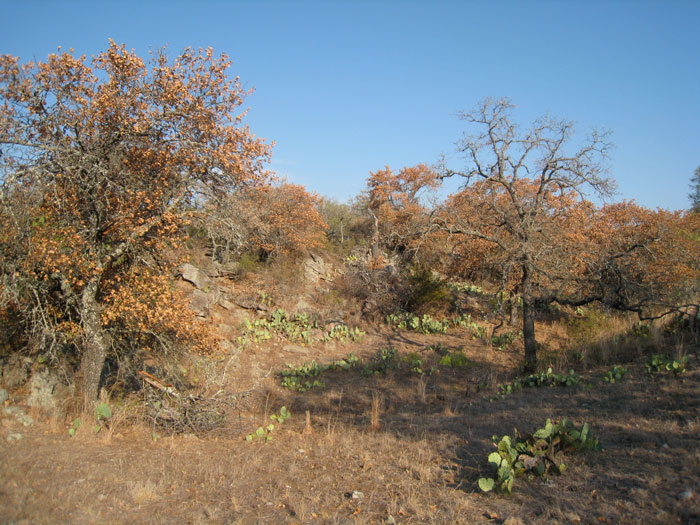
Below are some comparisons of the ranch in late spring/early summer, after El Niño years compared to after La Niña years:
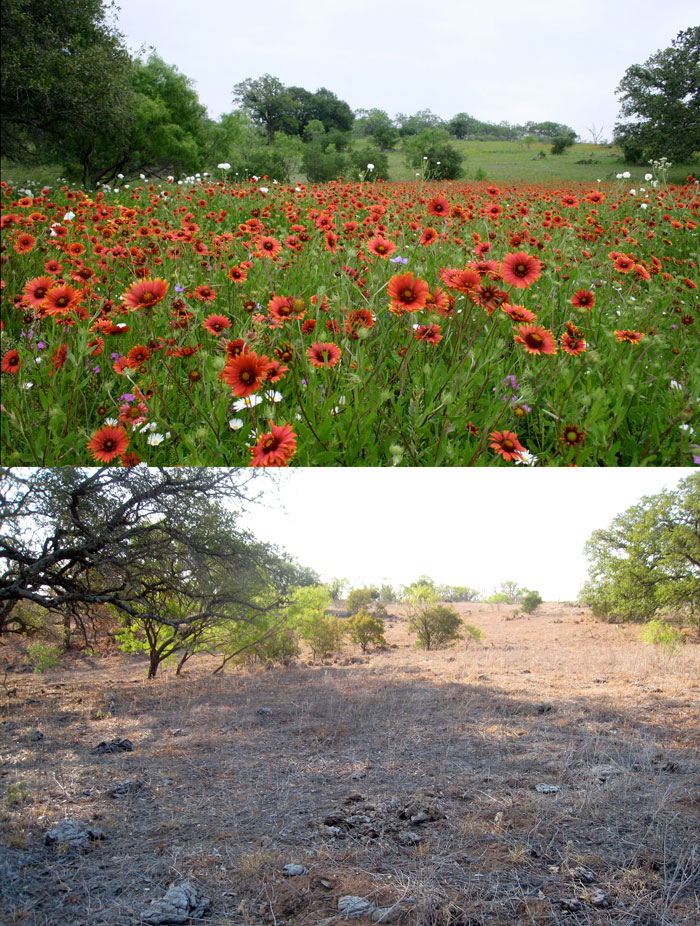
2007, after El Niño winter (top), versus same scene in 2011, after La Niña winter (bottom)
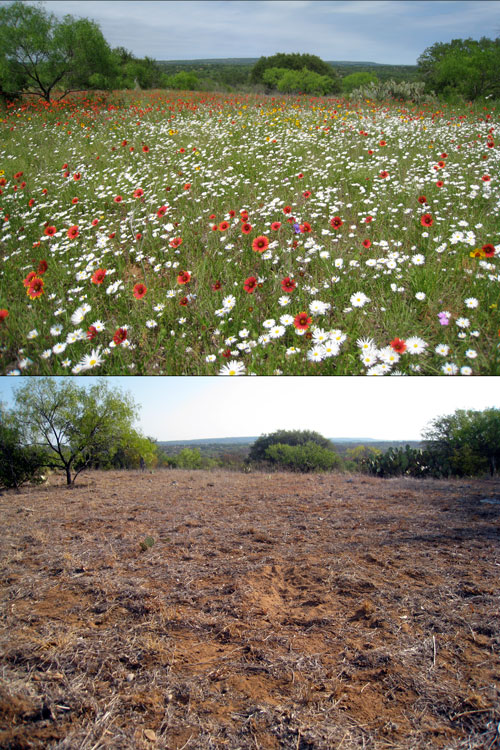
2010, after El Niño winter (top), versus same scene in 2011, after La Niña winter (bottom)
Update, 6 December 2011: We Are In Record Territory, But Finally Seeing Signs of a Weakening La Niña
People keep e-mailing me, hoping that I'll update this article with some good news. The best new news that I can think of since the last update in August is this: We are three months closer to the eventual end of this drought, and we are beginning to see some signs that the La Niña is finally weakening. By late September, we had completely busted all records for the lowest 12-month rainfall ever recorded, or even estimated from 500-year-old tree-ring studies, in Central Texas. At the Fly Gap Division of the Double Helix Ranch, we recorded 5.29" of rain from 26 September 2010 to 25 September 2011. That is about half of the lowest rainfall total ever recorded in the worst year of the early 1950s drought.
We are finally starting to see some changes in the La Niña weather pattern, however. We did get one good rainfall at Fly Gap in early October (our first rainfall of >2" in over a year), and that was followed by a few light rains (each less than a quarter of an inch) in November. That is well below our average rainfall for October and November, but considerably better than 2010, when only 0.05" fell in all of October and November. Then, on the first weekend in December, there were widespread soaking rains from a Pacific storm that slowly moved over Texas. The recent rains were enough to stimulate a lot of germination from seeds that were still waiting for last spring's rains! I've even noticed a few trees (overwise leafless from the summer drought) sprouting some new leaves, fooled into thinking it must be spring. Through the end November, we were still at just 8.82" of rain for the previous 12 months, which would have been a record low total anytime before September of this year. After this past weekend, we are now up to 11.05" for the past year...a remarkably low 12-month total, but half of that has fallen in the past two months!
The double-dip La Niña conditions continue, and are expected to continue into spring. About half of the models show a continuing weakening, and about half show some strengthening of the La Niña conditions. Although we have already received more rain than we did last winter (which was extreme, even for a La Niña), the drought is unlikely to end before the middle of 2012, at best. That means we can continue to expect a warmer, drier winter than average across much of Texas, but with more rainfall than last year. We are so far behind in rainfall now that it will take a long period of wet weather to pull us out of this.
The photos below show the Fly Gap Division of Double Helix Ranch as seen on Google Earth, and compare the view in October 2008 (when we were in a moderate drought) to October 2011 (our current, most severe one-year drought on record). Note that most of the oak trees (except along creekbeds) had lost their leaves by October 2011, and a large number of centuries-old oaks had died. The contrast between the green canopy cover in October 2008 and the brown, leafless trees in October 2011 is remarkable.
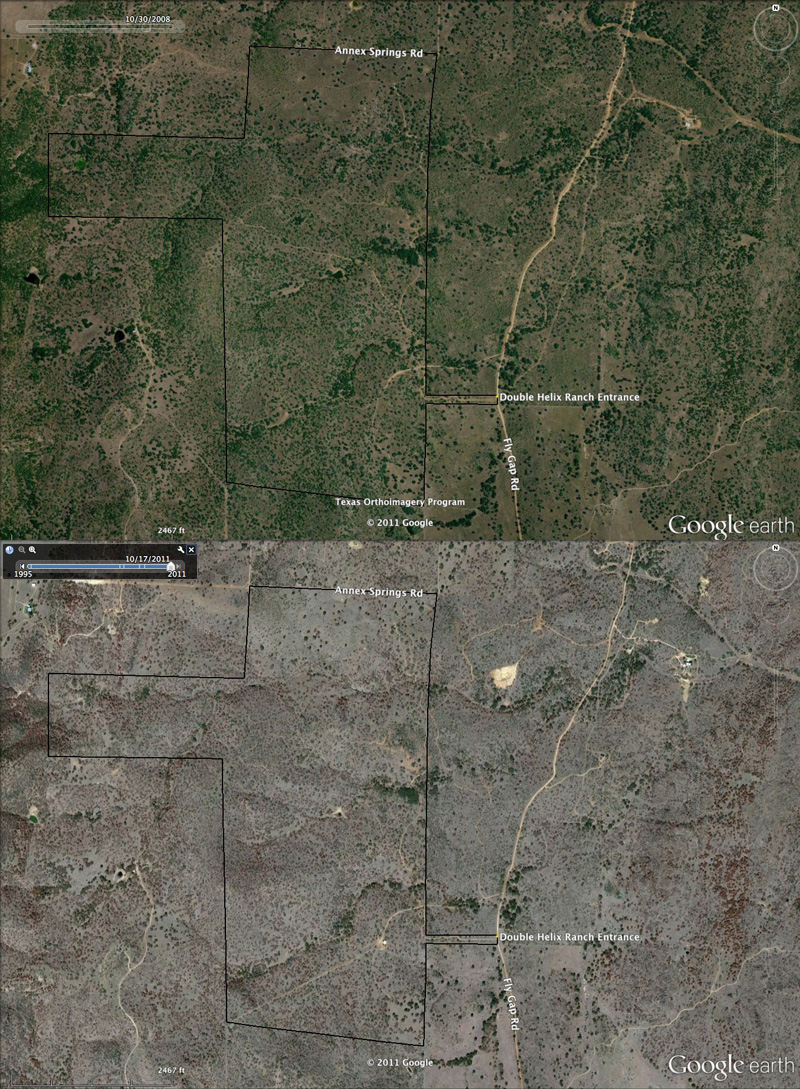
Update, 8 February 2012: Good Bye and Good Riddance, La Niña
We were pretty close to average in rainfall in central Texas over the past two months, and much warmer than normal. Some areas received more rainfall than average, and some less, of course. The combination of adequate rainfall and warm weather has resulted in some signs of GREEN in many areas, including on the Double Helix Ranch! We still have a long way to go to make up for our serious rainfall deficit over the past year, but things are certainly looking up. The latest models show a continuing weakening of the La Niña that has held us in prolonged drought:
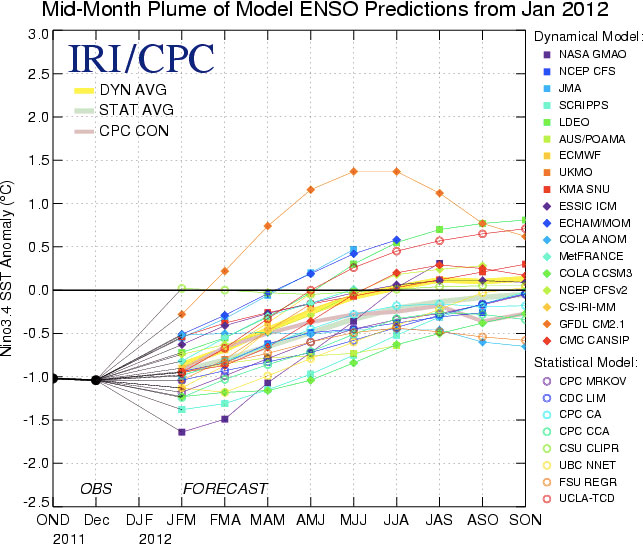
It looks like the La Niña will continue to weaken through Spring 2012, and that we are likely to be back to neutral conditions by this summer. It is more likely than not that we will still have below-average rainfall through the spring, but at least there are hopeful signs of improvement.
Update, 19 June 2012: 50% Chance for Development of El Niño Conditions by Fall
Summer is here, and our rainfall in central Texas has been close to normal so far this year, consistent with our neutral El Niño/La Niña conditions. It has been a huge improvement over last year's drought, even though conditions are still dry over much of Texas. But compare the drought conditions from last fall (when 100% of Texas was in drought, and 97% of Texas was in one of the worst two drought categories) with our current conditions (90% of Texas is still in drought, but only 6% of Texas is in the second-worst drought category, and 0% is in the worst category):
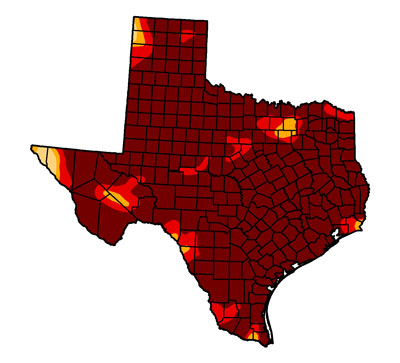
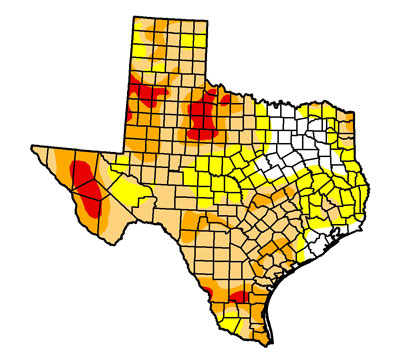
October 4, 2011 versus June 19, 2012 (U.S. Drought Monitor)
The chances for moving into a wet fall and winter are looking better as well. NOAA is now predicting a 50% chance of El Niño conditions developing by fall (with about an equal chance for continued neutral conditions, and very low chances for a return this fall of another La Niña):
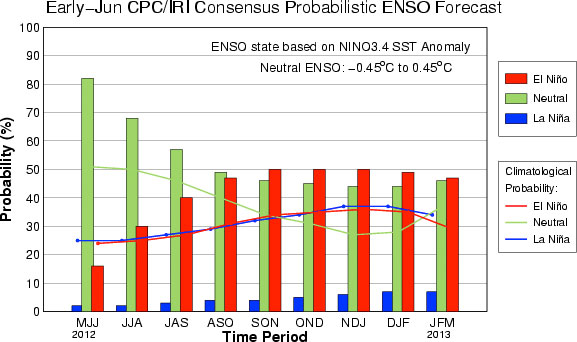
This is good news for our rain outlook this fall and winter! It is looking like we will likely be near normal in rainfall through the rest of the year (if we continue in neutral conditions), or have above average rainfall (if we move into El Niño conditions). Of course, individual El Niño seasons vary, and there are never any guarantees of increased rainfall, but at least the prospects for a wet fall and winter 2012-2013 in central Texas are looking up.
Update, 4 July 2012: The Ten Worst Droughts of the Last 117 Years
I've finally had a chance to analyze the rain records back to 1895, and produce a graph of the 12-month running rainfall for the past 117 years:
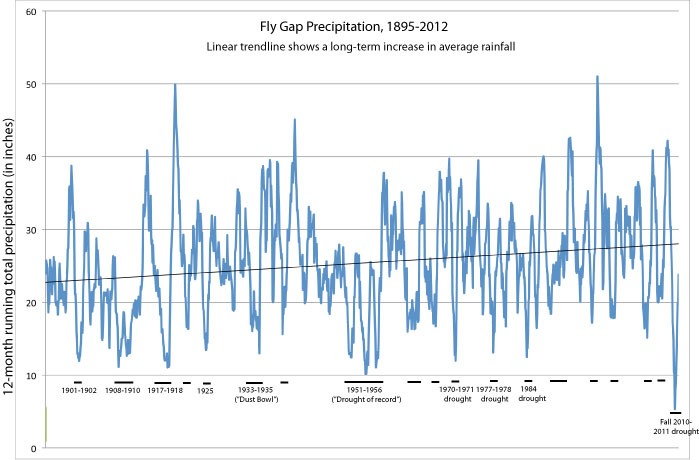
Several interesting points emerge from this:
1. Last year's drought really was remarkable, as last year was the only time since 1895 that we have dipped below 10" of rainfall in one 12-month period (we dropped all the way to 5").
2. Although no one year was ever as dry during the early 1950s drought as we were last year, the 1950s drought lasted far longer and overall was much more severe.
3. The 1930s "Dust Bowl" drought was not a remarkable drought in central Texas; some of the problems of that drought were related to unwise farming practices and the depressed economy. That drought was worse, however, in the panhandles of Texas and Oklahoma.
4. The long-term increase in rainfall at Fly Gap is clear: from an average of about 23" in the late 1800s, to an average of about 28" now (even with the data from our latest severe drought included).
5. Despite media reports to the contrary, only last year's drought was remarkable compared to the long-term record. Our other recent droughts have not stood out. I've labeled the ten driest periods from 1895-2012 (those in which we've dropped below 15" of rain for a 12-month period), and last year was the only one of these periods in the past quarter-century.
I'm working with some colleagues to compare the tree-ring data on our ranch with this rainfall record. Many centuries-old post oaks died on our ranch in 2011, and we have been cutting them down to compare the tree-ring record to the rainfall record. It should be interesting to see how they compare. It is remarkable that trees that lived through all the droughts on this graph were killed by the 2010-2011 drought.
Finally, the latest Pacific sea-surface temperatures are looking good for the development of El Niño conditions this fall. The eastern equatorial Pacific is already warming up, and the western equatorial Pacific looks like it is following. This is good news for our rain chances this fall and winter in central Texas:
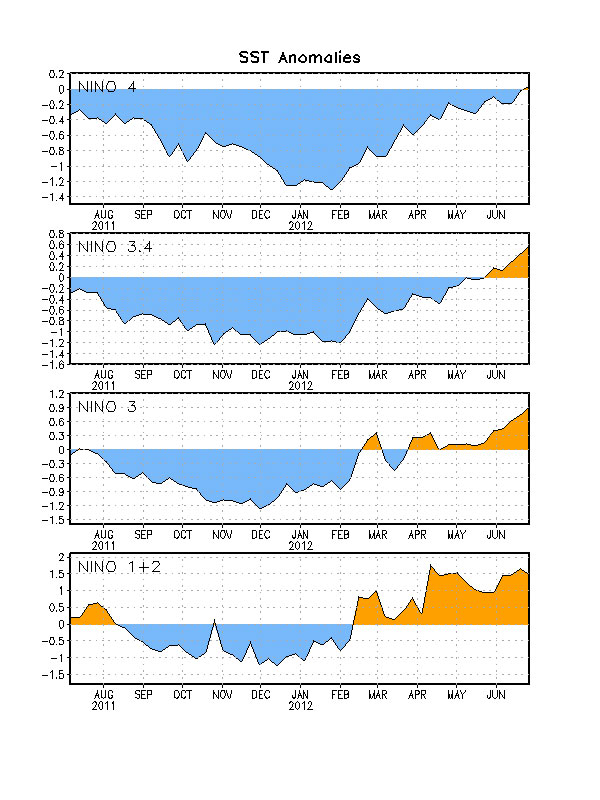
Update, 2 October 2012: Last year was the closest to "average" for rainfall that Texas has seen in a long time
As noted above, we have been slowly getting out of a La Niña pattern, and developing into a mild El Niño pattern, for most of the past year. Our weather is turning wetter, and it is certainly a big change from last year's record drought. But much evidence of the drought lingers: lakes are low, the loss of centuries-old trees is staggering, and agricultural production is still suffering. The worst of the drought has shifted north of Texas, into the midwestern plains states. So the news media in Texas can't seem to decide: Are we still in a drought? A wet period? What do we call this year?
In truth, the past water year (October 2011 through September 2012) was about as close to "average" as we ever get in Texas. If we look at the rain as a percentage of normal for this period, there are few places in Texas that deviated greatly from average this past year:
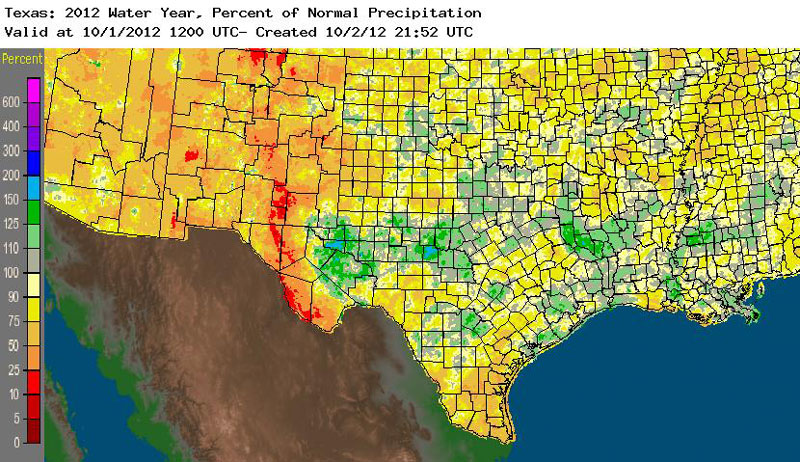
Most of the state is shaded from light yellow (slightly below average) to light green (slightly above average). In central Texas, we are basically right on the average. Far west Texas certainly remained very dry, and parts of the High Plains and south Texas were on the dry side. But central Texas lakes are still so low because the previous year was so dry, and an average year hasn't been enough to catch us up. Compare this map to the 2011 water year:
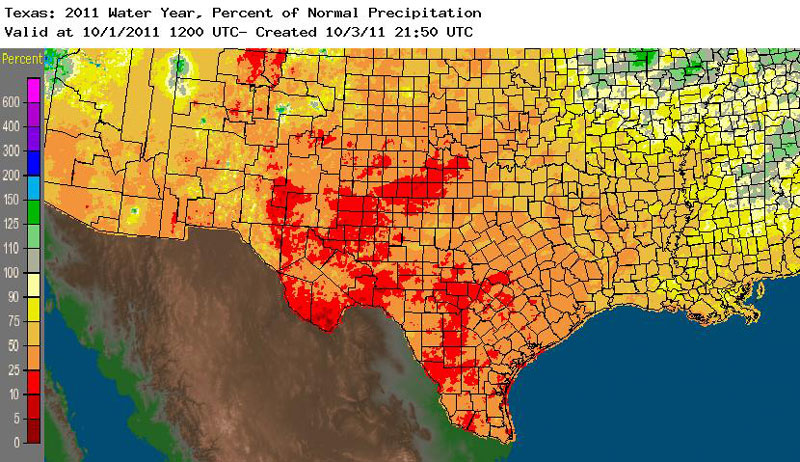
Note that virtually the entire state (except parts of northeast Texas) had under 50% of normal rainfall, and large parts (including the Double Helix Ranch in central Texas) had less than 25% of normal rainfall. That was certainly a bad drought year (in fact, our worst in recorded history).
Looking back at similar maps for the past several years, you can see that the patterns I've talked about for central Texas have actually held true for much of Texas. The cyclical droughts and wet periods are clearly visible at a larger scale. For example, the relatively wet 2010 El Niño year:
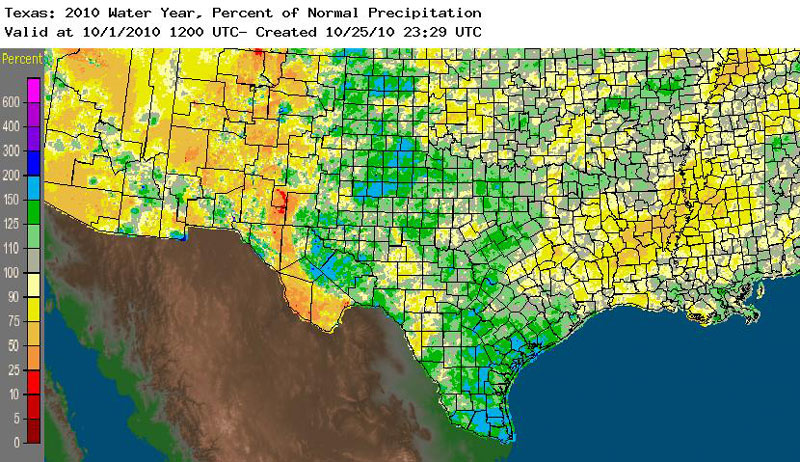
The 2010 wet period followed the dry 2009 water year, caused by a lingering La Niña (south of the Panhandle; this drought was worst in south and west Texas):

The dry year of 2009 was made more severe because it extended another dry La Niña year in 2008 (which was most severe in south-central Texas):
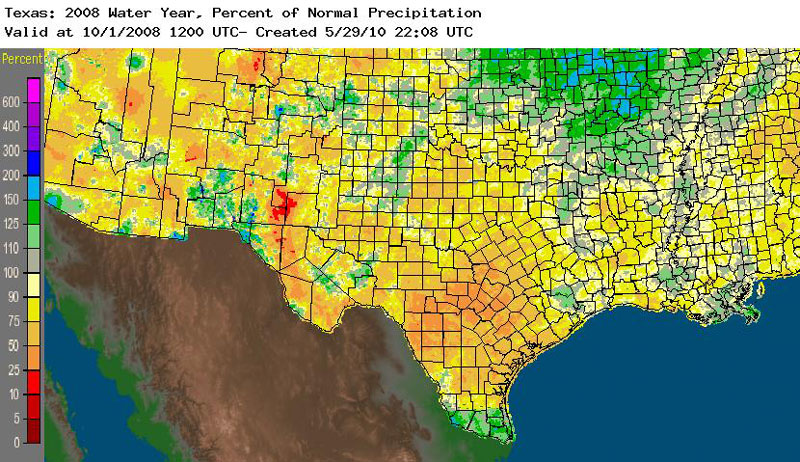
But 2007 was a wet El Niño year:

Which followed another dry La Niña year in 2006:
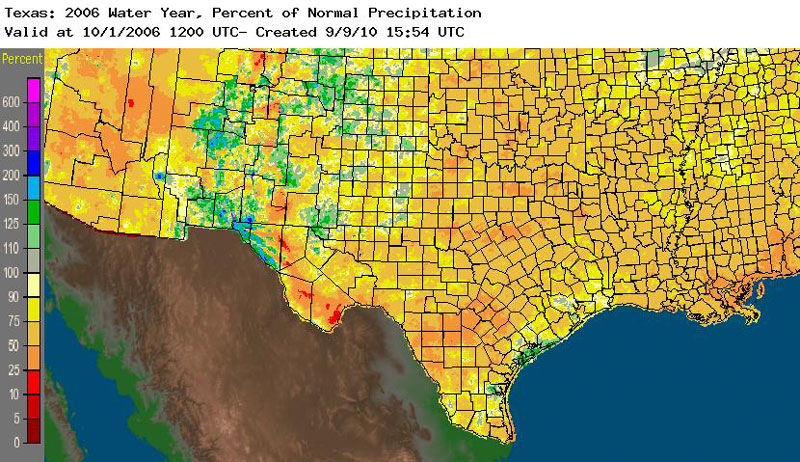
Hopefully, these maps clarify that the cyclical La Niña/El Niño pattern that can be seen in central Texas actually applies to much of Texas. The extremes of south Texas, west Texas, and the Panhandle are more likely to deviate, but the patterns apply to much of the state. Also note, however, that pockets of wetter or drier conditions are expected in any year. The predictions are for large geographical averages, not specific local rainfall totals.
So, now that we are in the part of the year that is most strongly affected by the La Niña/El Niño cycle, what can we expect? We are currently in slightly positive El Niño conditions, but not yet in a full El Niño episode. Most models suggest that we will have a moderate or weak El Niño this winter, which typically means somewhat wetter than normal weather:
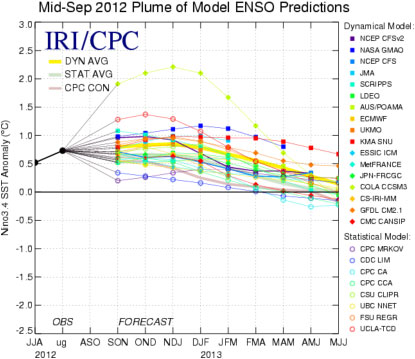
It is about twice as likely that we will have weak El Niño conditions, compared to the chances for neutral conditions, through the 2012-2013 winter. But fortunately an immediate return to La Niña conditions is unlikely. The bad news is that it looks likely that this El Niño will be short-lived:
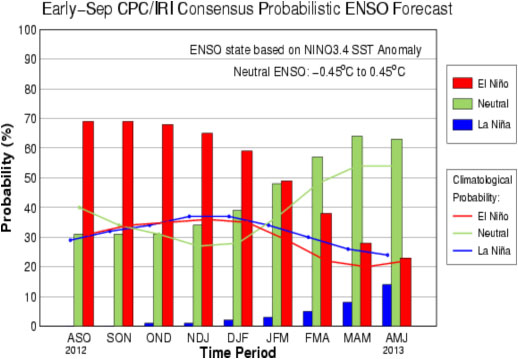
Update, 5 November 2012: Are we still in a drought? Yes and No...
We are still in essentially neutral El Niño/La Niña conditions, and it is looking like our chances of a strong El Niño this winter are disappearing. We have had a year of approximately normal rainfall, though, so are we out of the great drought of 2011? In some respects, yes, but the drought was so severe that it had long-term consequences, especially for ground- and surface-water storage. On the surface, soil moisture is near normal (or even wetter than normal in some areas of central Texas), but underground, the aquifers have not yet recharged. That means lower flow from springs, which means lower flow in creeks and rivers, which means lower flow into water storage reservoirs. This graphic from NOAA shows the contrast well:

Note that on the surface and in the root zone, we are normal-to-wet, but the ground-water storage is far below normal. The rains that have fallen have not yet been enough to recharge the aquifers.
Although the prospects for a very wet winter in central Texas are not looking good, it does not look like we are headed back into a La Niña, either. The expectation is that we will remain in neutral or near-neutral conditions for a while, which means that our rainfall should remain somewhere near normal. Here are the model predictions for the next year; note that most of the models keep us in neutral or very weak El Niño conditions:
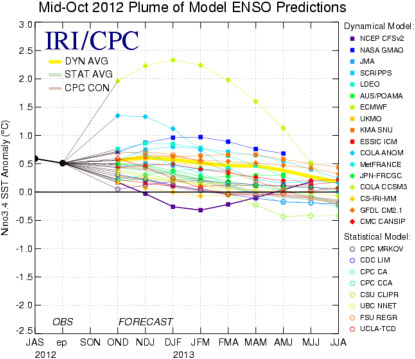
Update, 15 January 2013: A Quarter of a Year Without Rain
Most months have at least some rain. But from mid-October of 2012 to mid-January 2013 (last week), we had barely a trace. After a quarter of year without rain, we finally had a good rain (2.4") last week. That will certainly help stimulate the winter forbes and cool-season grasses, but three months without rain turned us from merely dry back into severe drought. This lack of rainfall happened despite neutral El Niño/La Niña conditions, which are expected to continue at least through the summer of 2013.
Update, 8 July 2013: Stuck in Neutral
Not much exciting to report on the El Niño/La Niña forecast. We continue to be stuck in ENSO (El Niño/Southern Oscillation)-neutral conditions, and that pattern likely to continue through the fall and winter of 2013-2014. It has now been over three years since the end of our last El Niño episode, and we have endured two La Niña episodes during that time. This explains our long and continuing drought. We typically have El Niño episodes every three to five years, so eventually the pattern should change. However, the models give little hope (less than 20% chance) of an El Niño episode developing this year. At least the chances of moving back into another La Niña episode are almost as low (see below). It appears likely that we will remain stuck in ENSO-neutral conditions until at least early next year:
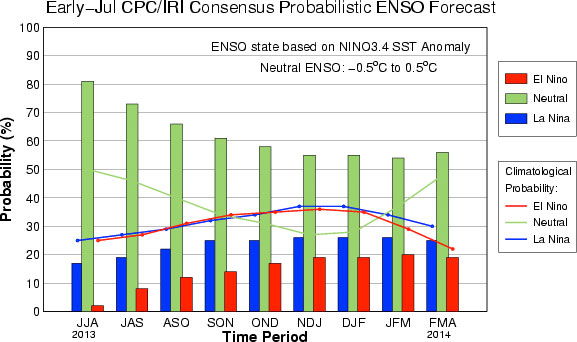
Update, 17 July 2013: Update of Fly Gap Rainfall Record
I updated the 12-month cumulative rainfall data for Fly Gap through June 2013. As can be seen below, after briefly returning to near-average rainfall in early 2012 (following the devastating drought of Fall 2010 and 2011), we started heading back into severe drought in Fall 2012. This "double-dip" drought is reminiscent of the first half of the "triple-dip" drought of the 1950s, although our current drought status is not yet nearly as severe as the second part of the 1950s drought. Areas just to our north had heavy rains this week, so some areas of central Texas show improvement in July.
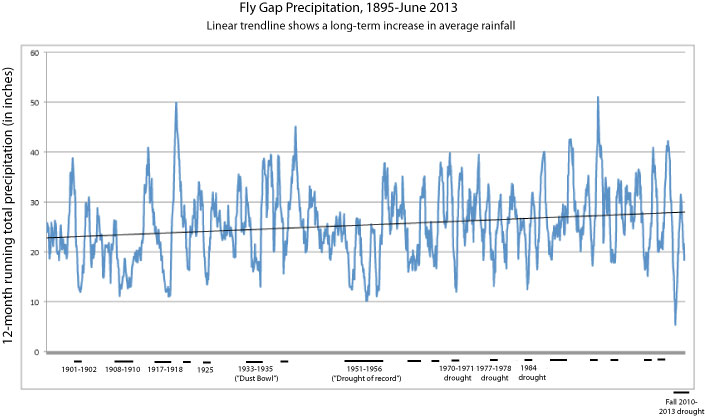
Update, 5 November 2013: Things are Looking Up This Fall
We've done pretty well for rain in September and October this fall, although we missed out on all the heavy rainfall that flooded Austin and vicinity twice in October. In fact, the entire watershed for the Highland Lakes (Austin's water supply) has still not received enough rain to produce much runoff, so the lakes are still near record lows. Austin, by contrast, had a record wet October, with serious flooding consequences. This was a result of the convergence of fronts producing a training of storms along the Balcones Escarpment near Austin (twice in as many weeks), with up to a foot of rain falling in places each time. But at Fly Gap, 100 miles to the west, we've had just over 22" of rain in the past 12 months, still well below the long term average. The tanks and streams are still low or not flowing, but there has been enough rain for some good grass growth this fall. The long-term forecast still indicates relatively neutral El Niño/La Niña conditions. Maybe we'll pull up closer to the annual average rainfall by year's end.
The big question is, when will we finally move into another El Niño episode, which should bring us much wetter weather? It doesn't look likely for this winter, but chances are beginning to look up for winter 2014-2015. Most models show an upward trend of sea-surface temperatures in the critical regions of the Pacific Ocean. It is still too far out to predict an El Niño event for next winter, but at least the trend is in that direction, finally:
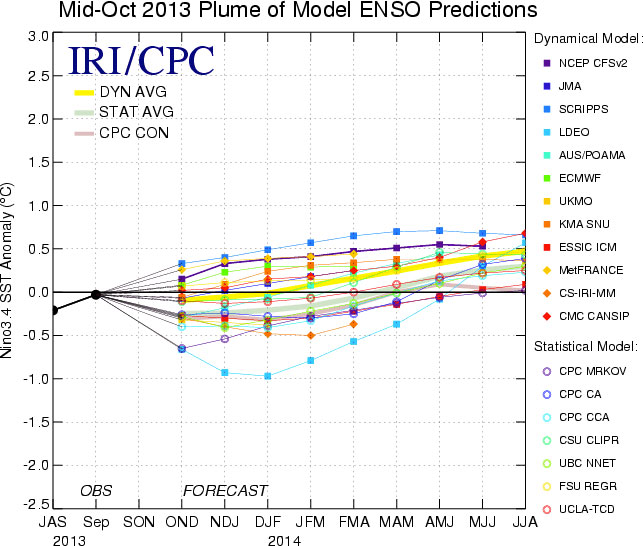
Update, 17 February 2014: Still Stuck in Neutral, But Chances for an El Niño are Looking Up for Next Winter
Yes, we are still very dry in central Texas. We haven't had an El Niño episode since 2010, and we haven't had a really strong El Niño since 1998. But there are signs that all this is likely to change over the next year or so.
First, the forecast on Pacific sea-surface temperatures (SSTs) in the regions of the equatorial Pacific that are important to El Niño forecasting:
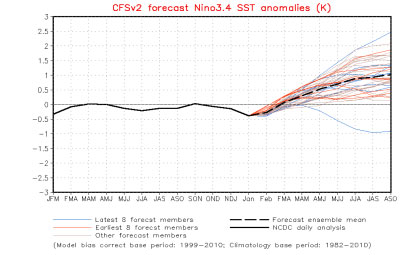
The models are not ALL in agreement, but the consensus forecast is clear: we are likely to continue with neutral El Niño/La Niña conditions for the rest of spring 2014, with a good chance of moving into El Niño conditions this fall. If we do, then our chances for a wetter-than-average fall–spring in 2014–2015 in central Texas will increase dramatically.
These conventional models are supported by a new study on long-range El Niño forecasting that was published just last week in the Proceedings of the National Academy of Sciences (PNAS 111:2064-2066). This paper suggests a 75% chance of an El Niño episode developing later this year.
Update, 6 April 2014: Chances for El Niño in 2014 Looking Good
The latest data and model forecasts show strong indications of a developing El Niño, possibly starting as early as this summer. NOAA continues to give an approximately 50% chance of an El Niño developing by next winter, although I expect those estimates will increase in the coming months. There is a very large area of warm water below the Pacific surface, and it is moving toward the surface and to the east. If this warm water reaches the surface of the equatorial Pacific, as it appears to be heading, we'll have El Niño conditions. Here is the subsurface temperature data that makes this look probable:
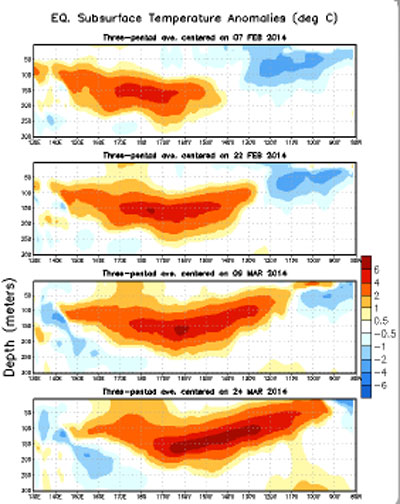
The vertical axis on the graph above shows depth, with the surface at the top. The horizontal axis shows longitude across the Pacific. The four panels are a time series, from 7 February at the top to 24 March at the bottom. That big red patch is warm water moving east and towards the surface. If it reaches the surface, we'll have El Niño conditions.
The latest forecast models are consistent with this scenario, and show El Niño conditions developing by early summer. In the graph below, the blue lines show the most recent model runs, most of which indicate a fairly strong El Niño developing. The maps on the right show the predicted conditions, which suggest a strong El Niño by the end of the year.
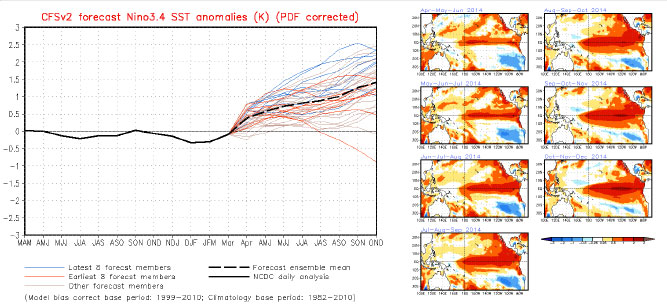
If these predictions continue to hold, we will have excellent chances for an end to our long drought in central Texas this fall and winter. That isn't guaranteed to happen, of course, but at least the conditions are finally looking good for change!
Update, 27 May 2014: Finally, a Good Soaking!
The past four days have brought a much needed soaking to much of Texas. We've had our heaviest rains in central Texas in many years (since well before the start of our drought in fall of 2010). A low pressure system set up over New Mexico, and then slowly moved east. Bands of disturbance brought wave after wave of thunderstorms across much of Texas (with a bull's-eye over west-central Texas), and there were widespread accumulations of 2-10" over the Memorial Day weekend:
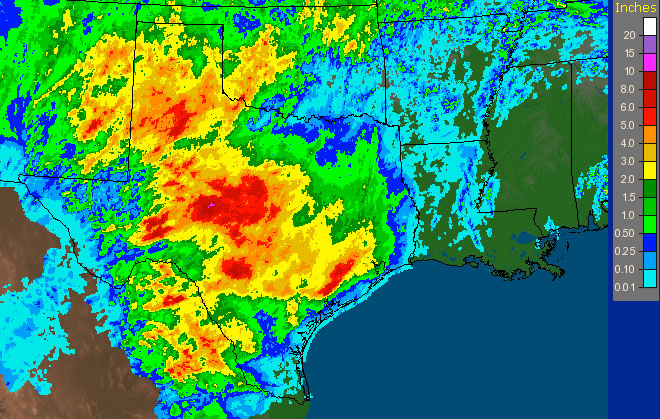
At the Fly Gap Division of the Double Helix Ranch near the center of the state, about 6" of rain fell over four days. Streams that have not flowed in five years are now flowing briskly, and all the ponds and tanks are full. This is a great start to the summer, and if the predicted El Niño rains come this fall and winter, we my finally be looking at the beginning of the end of our long drought.
Update, 4 September 2014: Still a Good Chance for a Moderate El Niño This Fall and Winter
We've had a few well-spaced and substantial rains this summer. We are now very close to our long-term average for the past 12 months. Aquifers and area lakes are still depleted from the long drought of the past four years, however. The good news is that the prospects for going above the long-term average in rainfall this fall and winter look pretty good. The graph below shows the latest sea-surface temperature predictions (based on many different models) for the El Niño region of the Pacific Ocean from the Climate Prediction Center:
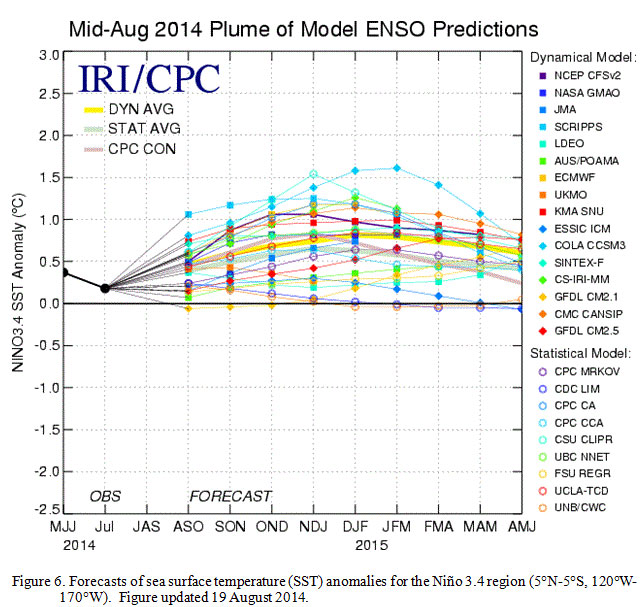
Note that most of the models predict a weak El Niño developing this fall, possibly beginning as early as this month. That suggests a wetter-than-average fall and winter for central Texas. It isn't a sure thing, but at least the conditions look good.
Update, 28 February 2015: We are actually back to about "normal" rainfall, despite continuing water supply problems
Another recent media report talks about our "record" current drought. But this water supply "drought" is mostly not a result of unusually low rainfall. Our record low water supplies and river flows are almost entirely a result of record human water use. The current crisis was indeed initiated by our record-low rainfall year in 2011. But since then, rainfall in Texas has not been unusually low by historical standards. Our water supplies haven't recovered because we are pumping and using more water from aquifers and surface waters than ever before. Here are the updated rainfall records from the Double Helix Ranch, near the geographic center of the state, from Jan 1895-Jan 2015. The graph shows the running 12-month cumulative rainfall, sampled monthly (so every point represents a full year of rainfall, thus eliminating any yearly seasonal effect). We are currently slightly above the long-term 12-month average. Also, note the three consecutive major droughts from 1951-1956. That drought was far worse than any other five-year period in recorded history, and certainly much worse than the past five years. Our 2011 drought was indeed the worst one-year drought on record, but rainfall has not been unusually low (compared to the historical average) since then. This follows the state-wide average patterns as well. Unless we start conserving and regulating water use, our human-made "drought" in Texas will be permanent...the current levels of water use are simply not sustainable.

The rainfall patterns continue to follow the El Niño/La Niña patterns in the Pacific. After the back-to-back La Niña episodes that started in late 2010 and ended in early 2012 (which resulted in our record 2011 drought), we have been in neutral El Niño/La Niña conditions, with close to average rainfall. Late last fall, we entered into marginal El Niño conditions (with sea-surface temperatures just above 0.5 C above the long-term average in the El Niño 3.4 region), and have remained there ever since. So, it is not surprising that our 12-month rainfall is now slightly above average. The big question is, where will we go from here? It looks like the marginal El Niño conditions are likely to stick around for a while, although we could also weaken back into neutral conditions later this year:
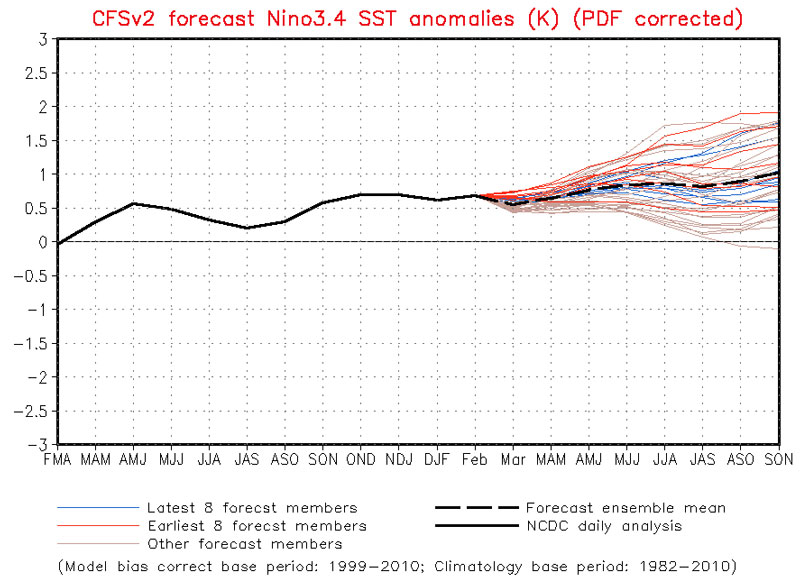
Although it is getting late in the 2014-2015 winter to expect much rainfall help from an El Niño, it does look like we have a better chance of a bigger El Niño episode developing or continuing into next winter, which could mean above-average rainfall in late 2015 and early 2016. In the predictions below, all that red in the Pacific is good news for our rainfall chances in central Texas (especially as we move into next fall and winter):
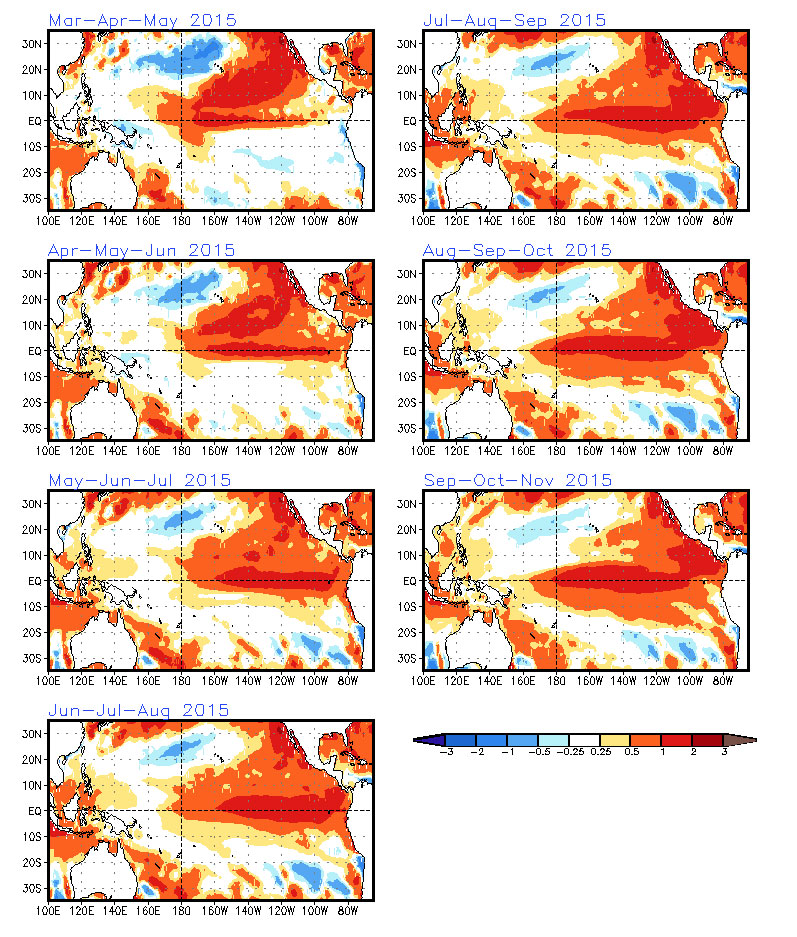
So far, our current weak El Niño looks like one of the "variant" El Niño episodes described in Impact of shifting patterns of Pacific Ocean warming on north Atlantic tropical cyclones; Science 325: 77-80 (see discussion above). In these variant El Niño episodes, the Pacific warming tends to occur more in the central Pacific than in the eastern Pacific (the classic El Niño pattern). Atlantic hurricanes tend to be suppressed during classic El Niños, which can actually reduce our summer/fall rainfall in central Texas (even though late fall to spring rainfall is increased). However, Atlantic hurricanes are not as suppressed in the variant El Niño episodes. So, those interested in Texas rainfall should be watching not just the development of warm water in the Pacific in 2015, but also where along the equator it is distributed.
Update, 4 May 2015: The El Niño looks likely to continue into the fall and winter, bringing us good chances for above-average rain
It now looks very likely that the current El Niño event will intensify this year, which is likely to continue to bring us wetter than average conditions. California is likely to get relief from their drought, as well. The greens and blues represent expected higher than normal precitation, in mm/day (green, < 1 mm/day; blue >1 mm/day over normal).
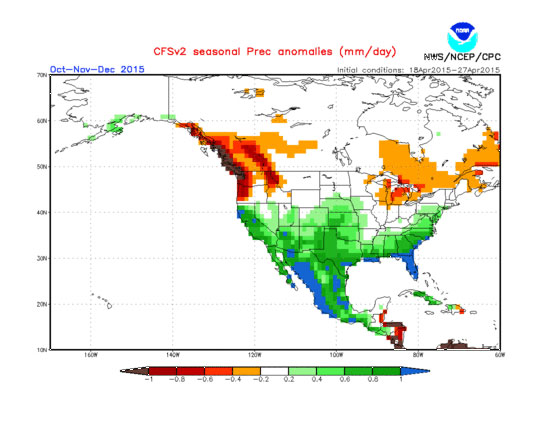
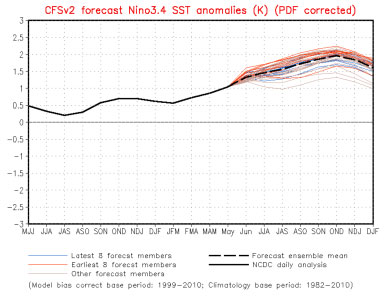
Update, 1 June 2015: The current El Niño gave us one of our wettest months of May ever
As expected under the strengthening El Niño episode, it is very wet in Texas. The developing massive El Niño gave us almost 10 inches of rain in May at the Double Helix Ranch, and some nearby areas received more than twice that amount (see map below), causing massive flooding. To put that in perspective, in a full year of the 2010-2011 drought, we received just 5 inches of rain. And the El Niño looks like it will intensify this fall and winter. So hang on to your hats.
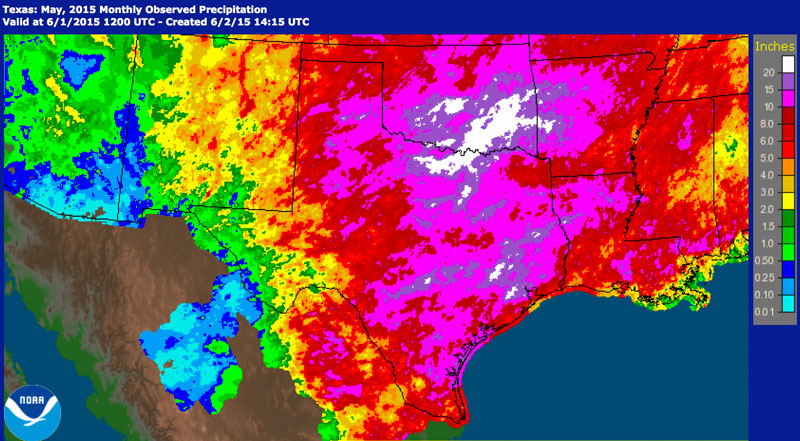
-----------------------------------------------------
For comments or queries, please contact:
David Hillis, Double Helix Ranch, doublehelix@att.net
